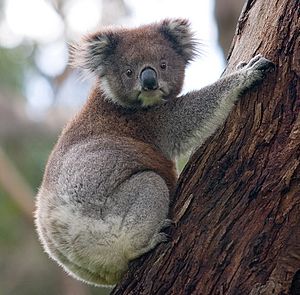Vombatiformes facts for kids
Quick facts for kids Vombatiformes |
|
|---|---|
 |
|
| Phascolarctos cinereus | |
| Scientific classification |
|
| Kingdom: | Animalia |
| Phylum: | Chordata |
| Class: | Mammalia |
| Infraclass: | Marsupialia |
| Order: | Diprotodontia |
| Suborder: | Vombatiformes Burnett, 1830 |
| Families | |
|
|
The Vombatiformes are a special group of animals called marsupials. Marsupials are mammals that carry their babies in a pouch, like kangaroos. This group includes the famous koalas and wombats. They are part of a bigger family of marsupials called Diprotodontia.
There used to be many more types of Vombatiformes. Out of nine known families, only two are still alive today. These are the Phascolarctidae family, which includes the koala, and the Vombatidae family, which has three kinds of wombats.
The name "Vombatiformes" means "wombat-shaped things" in a fancy old language called New Latin. This name was chosen because wombats are a key animal in this group.
Contents
Koalas and Wombats: The Survivors
Koalas and wombats are the only living members of the Vombatiformes group. They both have strong, compact bodies. Scientists believe that koalas and wombats came from a common ancestor a long time ago. They are closely related, even though they look and act a bit different today.
Other marsupial groups, like the Macropodiformes, include animals such as kangaroos, wallabies, and quokkas. The Phalangeriformes group includes possums and gliders. Vombatiformes stand out with their unique body shapes compared to these other groups.
Ancient Relatives: Giant Wombats and More
Many families within the Vombatiformes group are now extinct. This means they no longer exist. One of the most famous extinct families is the Diprotodontidae. This family included the Diprotodon, which was a huge, rhino-sized marsupial. Some people even think the Diprotodon might have inspired stories about the bunyip, a mythical creature from Australian Aboriginal folklore.
Another interesting extinct family is the Thylacoleonidae, also known as the "marsupial lions." These were powerful meat-eating marsupials, like the Thylacoleo. There were also "marsupial tapirs" from the Palorchestidae family, like the Palorchestes.
The Discovery of Mukupirna
In 2020, scientists announced a new discovery: Mukupirna nambensis. This animal belonged to its own family, Mukupirnidae. Its fossils were first found in Lake Eyre in 1973. Later, around 2010, they were rediscovered in a museum drawer in New York.
After studying these fossils, scientists learned that Mukupirna is the closest known fossil relative to the modern wombat family. This means they all shared a common ancestor. The name Mukupirna means "big bones" in the Diyari and Malyangapa languages. These are the languages of the Aboriginal people who live in the area where the fossils were found.
Classification: Family Tree
Here is a simplified look at the Vombatiformes family tree, showing some of the main groups:
Suborder Vombatiformes
- Family Vombatidae: This is the wombat family. It includes the three types of wombats alive today.
- Family Phascolarctidae: This is the koala family. It includes the one type of koala alive today.
- Family †Ilariidae: An extinct family.
- Family †Maradidae: An extinct family.
- Family †Mukupirnidae: This extinct family includes Mukupirna nambensis, the "big bones" marsupial.
- Family †Thylacoleonidae: These were the "marsupial lions," like Thylacoleo.
- Family †Wynyardiidae: An extinct family.
- Superfamily Diprotodontoidea: This group includes some very large extinct marsupials.
- Family †Diprotodontidae: These were the "giant wombats," like the huge Diprotodon.
- Family †Palorchestidae: These were the "marsupial tapirs," like Palorchestes.
- Groves, Colin (16 November 2005). Wilson, D. E., and Reeder, D. M. (eds). ed. Mammal Species of the World (3rd edition ed.). Johns Hopkins University Press. pp. 43–44. ISBN 0-801-88221-4. http://www.bucknell.edu/msw3.
Images for kids
-
A Vombatus ursinus in Australia.
-
An artist's idea of what the giant Diprotodon optatum might have looked like.
-
An artist's idea of what Palorchestes azael, a marsupial tapir, might have looked like.
See also
 In Spanish: Vombatiformes para niños
In Spanish: Vombatiformes para niños




